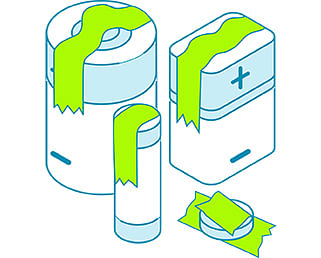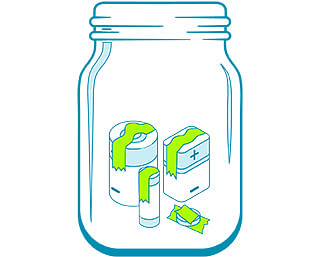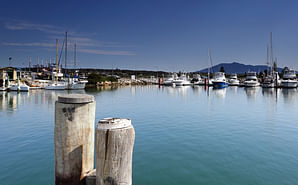Safe battery disposal
How to safely dispose of your household batteries.
Did you know that batteries are considered hazardous waste and should never be disposed of in your red-lid landfill or yellow-lid recycling bins?
Batteries can be a fire hazard if they are crushed or damaged and could spark to cause a fire in the back of the collections truck or at the Central Waste Facility landfill site near Wolumla.
90% of Australia’s old batteries end up in landfill, where they can leach toxic materials like mercury or lead into waterways and ecosystems. Batteries also contain valuable materials like magnesium and zinc, that can easily be recycled.
Here’s how to recycle them safely in 3 steps:
- Tape the terminals of your batteries – this prevents them sparking and creating a fire during transport and recycling

- Store batteries safely at home in a non-combustible, non-metal container (like glass) out of reach of children, for up to 6 months until you are ready to drop them off.

- Take batteries to one of the following dedicated recycle drop-off point for FREE:
- Community Recycling Stations - each of our Council libraries accept all AA, AAA, C, D, 9V and button batteries, and mobile phones and chargers.
- Community Recycling Centre at Merimbula Waste and Recycling Centre accepts all AA, AAA, C, D, 9V and button batteries, as well as car batteries, removable/rechargeable lithium-ion batteries like those found in cameras, power tools or other appliances, and automotive battery charging packs.
- B-cycle battery recycling bins can be found at all Woolworths, Big W, Mitre 10, Aldi and Total Tools stores in the Bega Valley, and they accept AA, AAA, C, D, 9V and button batteries. Some places also accept mobile phones and chargers, check before you drop them off.
What happens to your recycled batteries?
Once collected, the batteries are processed to recover plastics and metals that can be recycled into new batteries. Up to 95% of the materials in batteries can be recovered and reused, including plastics and metal (steel, aluminium and copper) in the casings. Components like cobalt, nickel and lithium are used to produce a mixed-metal dust which then is used to produce new lithium-ion batteries. Visit Envirostream for more information about the process.
These items are considered electronic, or ‘e’, waste, and can be taken to the Merimbula Waste and Recycling Centre for appropriate recycling. There is a fee to dispose of e-waste due to the transport costs involved in getting them to a recycler.
B-cycle is a national, government-backed product stewardship scheme that coordinates battery recycling with all aspects of the battery supply chain. It is run by the Battery Stewardship Council and is authorised by the ACCC. B-cycle supports and champions the responsible disposal and recycling of used batteries to minimise the loss of useful resources to landfill and to minimise harm to the environment through chemical leaching of batteries in landfill.
Batteries are a hazardous item and pose a fire risk to garbage collection trucks in landfills and a toxic chemical risk in our environment. They contain precious metals and resources that can be recovered and recycled.
Tape the ends or terminals of your batteries to prevent sparks occurring during storage and transport. Store them in a non-metal and non-combustible container like glass with a loose lid (to avoid pressure building up), for a period of no more than 6 months to avoid them starting to corrode. Keep them in a cool, dry place away from sources of ignition or heat like stoves, and out of the reach of children, as small batteries in particular can be easily swallowed and pose a serious choking and burns risk.






